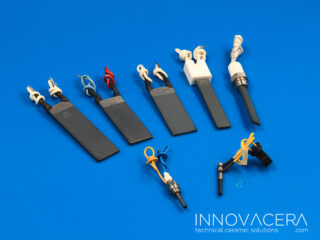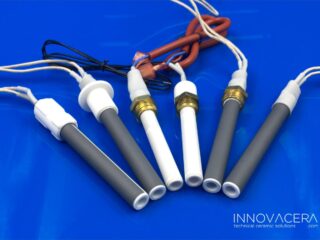In industrial thermal energy applications and household gas appliances, the ignition system is a core starting component whose performance directly determines the equipment’s starting efficiency, safety, and service life. Thanks to their superior high-temperature and corrosion resistance, silicon nitride hot surface igniters are gradually replacing traditional ignition components and becoming the preferred solution for high-end ignition scenarios.
As a company dedicated to the research, development, and production of silicon nitride hot surface igniters, we are deeply aware of the importance of this technology to industrial upgrades. This article analyzes the technical principles, application scenarios, core advantages, and comparative benefits in the boiler field to help industry partners gain a deeper understanding of this innovative product.
![]()
1. What is a Silicon Nitride Hot Surface Igniter
A silicon nitride hot surface igniter is a new type of ignition device that utilizes silicon nitride ceramic (Si₃N₄) as the core structural and heating matrix, combined with high-temperature resistant heating elements (such as tungsten or molybdenum wire).
Its core working principle is hot surface ignition—when electricity is applied, the internal heating element rapidly heats up, transferring heat to the surface of the silicon nitride ceramic. When the ceramic surface temperature reaches the ignition temperature of the fuel (typically between 300 and 800 °C, depending on the fuel type), it can instantly ignite the gas upon contact, eliminating the need for high-voltage spark ignition.
Structural Composition
The silicon nitride hot surface igniter mainly consists of three components:
Silicon nitride ceramic substrate:
Acts as the core carrier, offering high strength, excellent thermal shock resistance, high insulation, and long-term high-temperature performance above 1300 °C, preventing cracking or leakage hazards.
High-temperature resistant heating element:
Embedded within the ceramic matrix and made of high-melting-point metals or alloys, it rapidly reaches the required ignition temperature without melting during prolonged use.
Electrodes and leads:
Conduct current and maintain a stable connection with the heating element. The outer layer is typically wrapped in high-temperature resistant insulation to ensure circuit safety.
Compared with traditional spark ignition, the silicon nitride hot surface igniter provides more stable and reliable ignition unaffected by humidity, oil contamination, or environmental interference.
![]()
2. Application Scenarios
With the key characteristics of high-temperature resistance, corrosion resistance, and stable ignition, silicon nitride hot surface igniters have become the “starting core” of modern thermal energy equipment across industrial, household, and commercial sectors.
2.1 Industrial Thermal Energy Equipment
Industrial boilers and furnaces:
Including gas boilers, oil boilers, hot air furnaces, and ceramic kilns, which require stable ignition in high-temperature, high-dust, and corrosive environments. The corrosion resistance of silicon nitride ceramics ensures long-term, reliable operation.
Industrial burners:
Used in metallurgical heating furnaces and chemical reactors, where frequent, rapid ignition is required. The “instant-on, instant-heating” capability of silicon nitride igniters significantly improves start-up efficiency.
2.2 Household Gas Equipment
Gas water heaters and wall-mounted boilers:
Traditional ignition electrodes are prone to scaling and gas impurities, leading to ignition failure. Silicon nitride igniters, with their smooth surface and anti-scaling properties, extend service life and reduce maintenance frequency.
Gas stoves and integrated stoves:
Operate under direct flame exposure. The high-temperature resistance of silicon nitride ceramics prevents deformation or damage from long-term heat. Moreover, ignition reliability is unaffected by oil dripping from cookware.
2.3 Commercial Thermal Energy Equipment
Commercial kitchen appliances:
Such as large gas frying pans, steamers, and ovens, which operate in high-temperature environments with frequent usage. Silicon nitride igniters adapt well to high-intensity workloads and minimize downtime for maintenance.
Commercial heating equipment:
Large gas heating boilers in hotels and shopping centers must ignite reliably in low-temperature environments. Silicon nitride igniters can operate reliably between -40 °C and 1300 °C, ensuring no ignition failures even in winter conditions.
3. Case Study: Industrial Boiler Upgrade
In one chemical plant, replacing traditional ignition electrodes with silicon nitride hot surface igniters led to the following improvements:
Start-up success rate increased from 85% to 100%.
Replacement frequency of ignition components extended from once every four months to once every two years.
Maintenance downtime reduced by approximately 12 hours per year.
Operation and maintenance costs reduced by more than 40%.
Additionally, the switch completely eliminated safety hazards associated with corrosion and leakage in traditional ignition electrodes.
![]()
4. Conclusion
From material innovation to technological implementation, silicon nitride hot surface igniters are redefining ignition system standards through superior performance, providing efficient, reliable, and safe ignition solutions for industrial boilers, household gas appliances, and commercial thermal energy equipment.
As a company dedicated to the R&D and production of silicon nitride hot surface igniters, we will continue to advance in material processing and product design, delivering high-quality products that help our partners reduce costs, increase efficiency, and achieve industrial upgrading and transformation, jointly promoting technological innovation in thermal energy applications.
For more information, please contact us at sales@innovacera.com.




 Enquiry
Enquiry